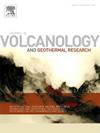Modeling magma recharge dynamics during the 2016 Nevados de Chillan eruption: An interacting two-chamber system evidenced by petrology and geodesy
IF 2.4
3区 地球科学
Q2 GEOSCIENCES, MULTIDISCIPLINARY
Journal of Volcanology and Geothermal Research
Pub Date : 2025-02-01
DOI:10.1016/j.jvolgeores.2024.108253
引用次数: 0
Abstract
The Nevados de Chillan is a large composite stratovolcanic complex located in the Southern Andean Volcanic Zone, at the south of Chile. Its last eruption spanned six years from January 8, 2016 until January 2023. After three years without any deformation, exhibiting phreatic and phreatomagmatic activity, an uplift episode was reported in June 2019, marking the start of its magmatic phase. How this geodetic activity evolved in the following three years is still not clear, neither how it correlates with its superficial activity. Here we analyze InSAR time series, as well as daily GNSS time series from 2015 to early 2022, highlighting the wide range of ground surface displacements observed during the eruption. In-depth analysis of these displacements together with recent petrological and geochemical results leads us to consider a recharge mechanism involving a double-reservoir model to explain the observed geodetic activity. We develop an analytical model of dynamic magma flow, which we coupled with a boundary element method to account for any geometry of the reservoirs and the topography of the volcano. The model consists of a shallow elongated source located at 5.8 km depth below the volcanic edifice connected by an incompressible magma-filled hydraulic pipe to a deeper sill like source centered at 15 km depth. We propose that the activation of the system started with a small magma intrusion of one month of duration, which was sufficient to overheat the hydrothermal system and re-mobilize magma in the shallow chamber, thus explaining the non-deformation during its phreatic phase and the slight subsidence observed during its phreato-magmatic stage. Then, we propose that a new and larger magma intrusion occurred in June 2019, explaining the uplift episode observed, which continued for the following three years of the eruption, decaying exponentially. Our model indicates that this intrusion was triggered by magma coming from the crust-mantle boundary to the deep reservoir at constant rate of 0.016 km3y−1 from June 2019 to Jan. 2022, with small changes to this rate that would explain the small fluctuations observed during this uplift episode. We show that the conduit-dominated magma transfer between both reservoirs controls the dynamics of the system. A deep mafic reservoir recharging an evolved shallow reservoir would explain the mafic enclaves found in the dacites in the latter eruption and thus offers a physical model to jointly explain the observations we get from petrology, geochemistry and geophysics, bridging the disciplines. The model presented here can be used to study potential recharge mechanism occurring in the different stages of an eruptive cycle including pre-eruptive, co-eruptive and post-eruptive stages.
2016 年奇兰内瓦多斯火山爆发期间的岩浆补给动力学建模:岩石学和大地测量学证明的互动双室系统
内华达德奇兰是一个大型复合层状火山群,位于智利南部的南安第斯火山带。它的最后一次喷发从2016年1月8日持续到2023年1月,历时6年。经过三年没有任何变形,表现出潜水和潜水岩浆活动,2019年6月报道了一次隆起事件,标志着其岩浆阶段的开始。这种大地测量活动在接下来的三年里是如何演变的仍然不清楚,也不清楚它与地表活动之间的关系。在这里,我们分析了2015年至2022年初的InSAR时间序列以及每日GNSS时间序列,突出显示了火山喷发期间观测到的大范围地表位移。对这些驱替的深入分析以及最近的岩石学和地球化学结果使我们考虑到一种涉及双储层模型的补给机制来解释观测到的大地活动。我们开发了一个动态岩浆流动的解析模型,我们结合了边界元方法来解释水库的任何几何形状和火山的地形。该模型由一个位于火山大厦以下5.8公里深度的浅细长震源组成,该震源由一条不可压缩的充满岩浆的液压管道连接到一个位于15公里深度的更深层的基泊状震源。我们认为,该系统的激活始于持续一个月的小岩浆侵入,这足以使热液系统过热并重新调动浅室中的岩浆,从而解释了其在潜水阶段不变形和在潜水-岩浆阶段观察到的轻微下沉。然后,我们提出2019年6月发生了一次新的更大的岩浆入侵,这解释了观测到的隆起事件,该事件持续了火山喷发后的三年,呈指数衰减。我们的模型表明,从2019年6月到2022年1月,岩浆以0.016 km3y−1的恒定速率从壳幔边界进入深部储层,引发了这次入侵,这一速率的微小变化可以解释在这次隆起事件中观察到的小波动。研究表明,两个储层之间以导管为主的岩浆转移控制着系统的动力学。一个深基性储层补充一个进化的浅储层可以解释在英安岩中发现的基性包裹体,从而提供一个物理模型来共同解释我们从岩石学、地球化学和地球物理学中得到的观察结果,架起了桥梁。该模型可用于研究喷发周期不同阶段的潜在补给机制,包括喷发前阶段、喷发共阶段和喷发后阶段。
本文章由计算机程序翻译,如有差异,请以英文原文为准。
求助全文
约1分钟内获得全文
求助全文
来源期刊
CiteScore
5.90
自引率
13.80%
发文量
183
审稿时长
19.7 weeks
期刊介绍:
An international research journal with focus on volcanic and geothermal processes and their impact on the environment and society.
Submission of papers covering the following aspects of volcanology and geothermal research are encouraged:
(1) Geological aspects of volcanic systems: volcano stratigraphy, structure and tectonic influence; eruptive history; evolution of volcanic landforms; eruption style and progress; dispersal patterns of lava and ash; analysis of real-time eruption observations.
(2) Geochemical and petrological aspects of volcanic rocks: magma genesis and evolution; crystallization; volatile compositions, solubility, and degassing; volcanic petrography and textural analysis.
(3) Hydrology, geochemistry and measurement of volcanic and hydrothermal fluids: volcanic gas emissions; fumaroles and springs; crater lakes; hydrothermal mineralization.
(4) Geophysical aspects of volcanic systems: physical properties of volcanic rocks and magmas; heat flow studies; volcano seismology, geodesy and remote sensing.
(5) Computational modeling and experimental simulation of magmatic and hydrothermal processes: eruption dynamics; magma transport and storage; plume dynamics and ash dispersal; lava flow dynamics; hydrothermal fluid flow; thermodynamics of aqueous fluids and melts.
(6) Volcano hazard and risk research: hazard zonation methodology, development of forecasting tools; assessment techniques for vulnerability and impact.

 求助内容:
求助内容: 应助结果提醒方式:
应助结果提醒方式:


